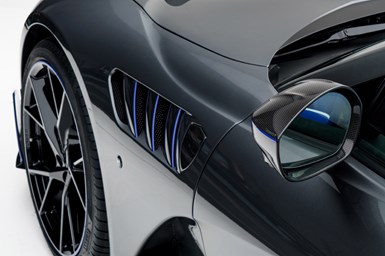Mansory Stallone GTS optimizes vehicle with carbon fiber
Complete vehicle conversion includes performance upgrade, interior modifications and carbon fiber add-on components.

Mansory Stallone GTS (MY21). All photo credit: Mansory
Mansory (Brand, Germany) presents a completed conversion of the two-door Mansory Stallone GTS (MY21) to meet the demands of open-top driving. The complete vehicle conversion follows the company’s three-generation refinement of the Ferrari Gran Turismo based on the 599 GTB, the F12 and the Ferrari 812 Superfast, a convertible version. In addition to a performance upgrade and interior modifications, Mansory says its design includes carbon fiber body components.

Carbon fiber structures — front apron, side skirts, rear apron with diffuser and the vehicle’s rear trim — are finished in black and gray carbon fiber. Additional optimized features include a Retractable Hardtop (RHT), which can be opened and closed in a 14 seconds. The 6.5-liter V12 engine has been refined with an engine output increased to 830 horsepower (or 611 kilowatts). Maximum torque has been increased to 740 newton meters. Engine power has been further improved with adapted suspension components and one-piece, ultra-light forged wheels with the designation “YN.5”; rims are 9.5 x 21 and 12 x 22 with high-performance tires in the sizes 265/30 ZR21 (VA) and 335/25 ZR22 (HA).
Interior upgrades improve functionality and comfort for the user.
Related Content
-
Infinite Composites: Type V tanks for space, hydrogen, automotive and more
After a decade of proving its linerless, weight-saving composite tanks with NASA and more than 30 aerospace companies, this CryoSphere pioneer is scaling for growth in commercial space and sustainable transportation on Earth.
-
Co-molding SMC with braided glass fiber demonstrates truck bed potential
Prepreg co-molding compound by IDI Composites International and A&P Technology enables new geometries and levels of strength and resiliency for automotive, mobility.
-
Cryo-compressed hydrogen, the best solution for storage and refueling stations?
Cryomotive’s CRYOGAS solution claims the highest storage density, lowest refueling cost and widest operating range without H2 losses while using one-fifth the carbon fiber required in compressed gas tanks.













